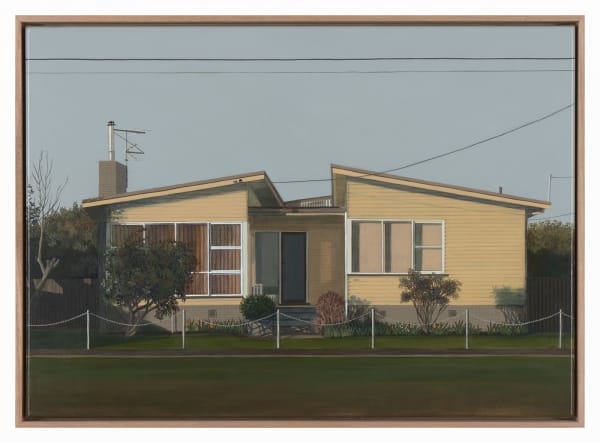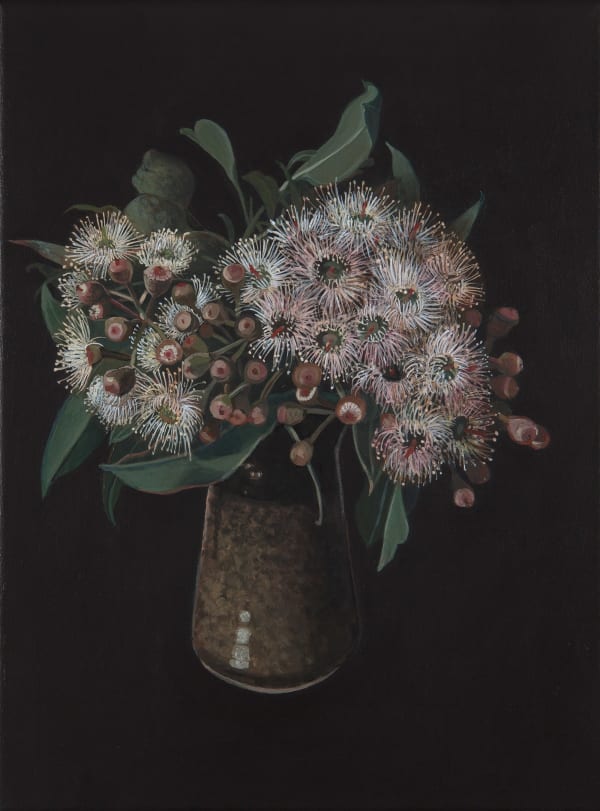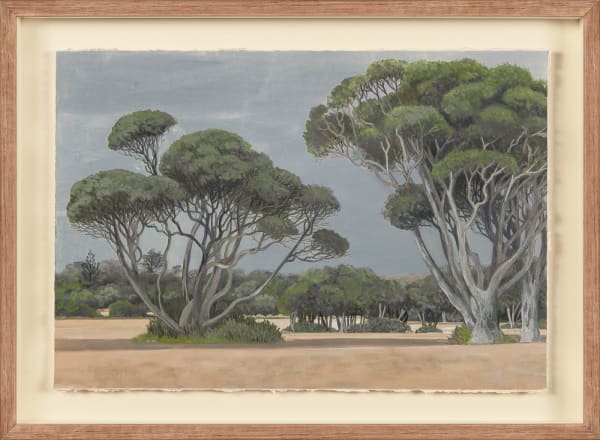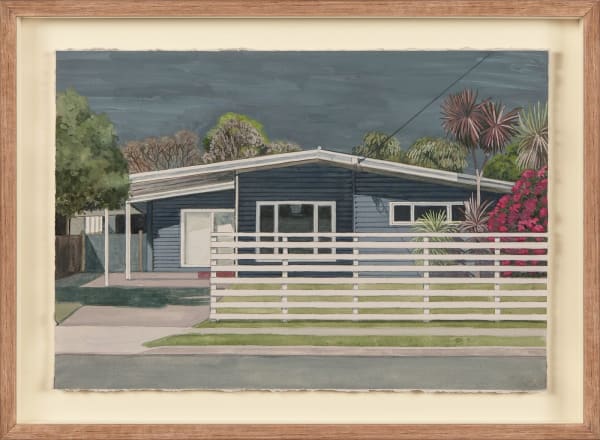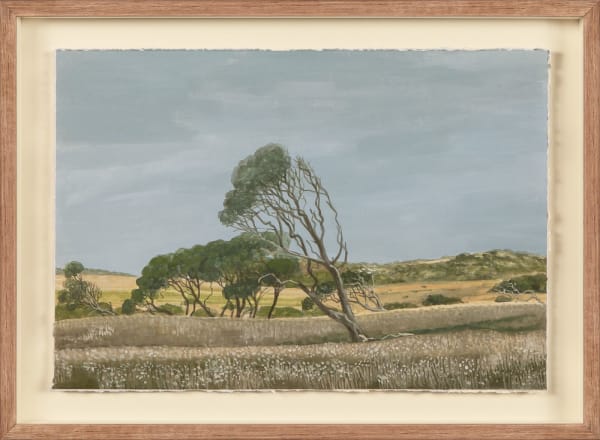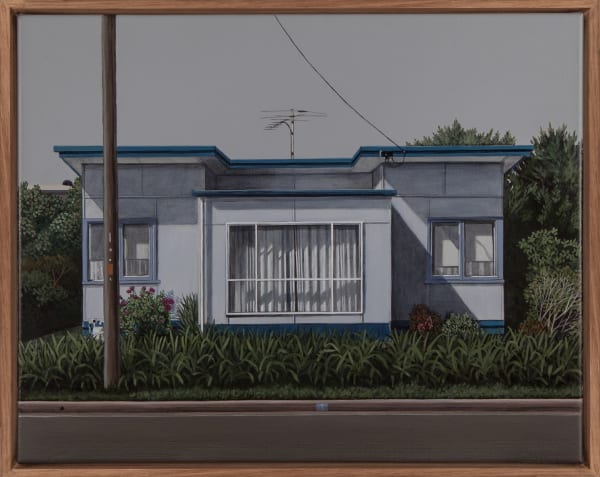Robyn Sweaney: Hidden in Plain Sight
-
 Robyn SweaneyBehind the Walls, 2020acrylic on polycotton70 x 150 cm, 73 x 153 cm (framed)
Robyn SweaneyBehind the Walls, 2020acrylic on polycotton70 x 150 cm, 73 x 153 cm (framed) -
 Robyn SweaneyBetween Two Worlds, 2020acrylic on polycotton50 x 70 cm, 53 x 73 cm (framed)
Robyn SweaneyBetween Two Worlds, 2020acrylic on polycotton50 x 70 cm, 53 x 73 cm (framed) -
 Robyn SweaneyDwell I, 2020graphite on paper14.8 x 21 cm, 22 x 27 cm (framed)Sold
Robyn SweaneyDwell I, 2020graphite on paper14.8 x 21 cm, 22 x 27 cm (framed)Sold -
 Robyn SweaneyDwell II, 2020graphite on paper14.8 x 21 cm, 22 x 27 cm (framed)Sold
Robyn SweaneyDwell II, 2020graphite on paper14.8 x 21 cm, 22 x 27 cm (framed)Sold -
 Robyn SweaneyDwell III, 2019graphite on paper14.8 x 21 cm, 22 x 27 cm (framed)
Robyn SweaneyDwell III, 2019graphite on paper14.8 x 21 cm, 22 x 27 cm (framed) -
 Robyn SweaneyDwell IV, 2019graphite on paper14.8 x 21 cm, 22 x 27 cm (framed)
Robyn SweaneyDwell IV, 2019graphite on paper14.8 x 21 cm, 22 x 27 cm (framed) -
 Robyn SweaneyDwell IX, 2019graphite on paper14.8 x 21 cm
Robyn SweaneyDwell IX, 2019graphite on paper14.8 x 21 cm -
 Robyn SweaneyDwell V, 2019graphite on paper14.8 x 21 cm, 22 x 27 cm (framed)
Robyn SweaneyDwell V, 2019graphite on paper14.8 x 21 cm, 22 x 27 cm (framed) -
 Robyn SweaneyDwell VI, 2019graphite on paper14.8 x 21 cm, 22 x 27 cm (framed)
Robyn SweaneyDwell VI, 2019graphite on paper14.8 x 21 cm, 22 x 27 cm (framed) -
 Robyn SweaneyDwell VII, 2019graphite on paper14.8 x 21 cm, 22 x 27 cm (framed)
Robyn SweaneyDwell VII, 2019graphite on paper14.8 x 21 cm, 22 x 27 cm (framed) -
 Robyn SweaneyDwell VIII, 2019graphite on paper14.8 x 21 cm
Robyn SweaneyDwell VIII, 2019graphite on paper14.8 x 21 cm -
 Robyn SweaneyDwell X, 2019graphite on paper14.8 x 21 cm, 22 x 27 cm (framed)
Robyn SweaneyDwell X, 2019graphite on paper14.8 x 21 cm, 22 x 27 cm (framed) -
 Robyn SweaneyDwell XI, 2019graphite on paper14.8 x 21 cm
Robyn SweaneyDwell XI, 2019graphite on paper14.8 x 21 cm -
 Robyn SweaneyDwell XII, 2019graphite on paper14.8 x 21 cm, 22 x 27 cm (framed)
Robyn SweaneyDwell XII, 2019graphite on paper14.8 x 21 cm, 22 x 27 cm (framed) -
 Robyn SweaneyEquilibrium, 2018acrylic on polycotton50 x 70 cm, 53 x 73 cm (framed)
Robyn SweaneyEquilibrium, 2018acrylic on polycotton50 x 70 cm, 53 x 73 cm (framed) -
 Robyn SweaneyHeartland I, 2020acrylic on polycotton36 x 28 cm, 39 x 31 cm (framed)
Robyn SweaneyHeartland I, 2020acrylic on polycotton36 x 28 cm, 39 x 31 cm (framed) -
 Robyn SweaneyHeartland II, 2020acrylic on polycotton36 x 28 cm, 39 x 31 cm (framed)Sold
Robyn SweaneyHeartland II, 2020acrylic on polycotton36 x 28 cm, 39 x 31 cm (framed)Sold -
 Robyn SweaneyHeartland III, 2020acrylic on polycotton36 x 28 cm, 39 x 31 cm (framed)
Robyn SweaneyHeartland III, 2020acrylic on polycotton36 x 28 cm, 39 x 31 cm (framed) -
 Robyn SweaneyHeartland IV, 2020acrylic on polycotton36 x 28 cm, 39 x 31 cm (framed)
Robyn SweaneyHeartland IV, 2020acrylic on polycotton36 x 28 cm, 39 x 31 cm (framed) -
 Robyn SweaneyHidden in Plain Sight, 2020acrylic on polycotton56 x 67 cm, 59 x 70 cm (framed)
Robyn SweaneyHidden in Plain Sight, 2020acrylic on polycotton56 x 67 cm, 59 x 70 cm (framed) -
 Robyn SweaneyHouse Study I, 2020graphite on paper14.8 x 21 cm, 22 x 27 cm (framed)Sold
Robyn SweaneyHouse Study I, 2020graphite on paper14.8 x 21 cm, 22 x 27 cm (framed)Sold -
 Robyn SweaneyHouse Study II, 2020graphite on paper14.8 x 21 cm, 22 x 27 cm (framed)Sold
Robyn SweaneyHouse Study II, 2020graphite on paper14.8 x 21 cm, 22 x 27 cm (framed)Sold -
 Robyn SweaneyHouse Study III, 2020graphite on paper14.8 x 21 cm, 22 x 27 cm (framed)
Robyn SweaneyHouse Study III, 2020graphite on paper14.8 x 21 cm, 22 x 27 cm (framed) -
 Robyn SweaneyHouse Study IV, 2020graphite on paper14.8 x 21 cm, 22 x 27 cm (framed)Sold
Robyn SweaneyHouse Study IV, 2020graphite on paper14.8 x 21 cm, 22 x 27 cm (framed)Sold -
 Robyn SweaneyLost in Thought, 2020acrylic on polycotton40 x 50 cm, 43 x 53 cm (framed)
Robyn SweaneyLost in Thought, 2020acrylic on polycotton40 x 50 cm, 43 x 53 cm (framed) -
 Robyn SweaneyLovestruck, 2019acrylic on linen47 x 28 cm, 50 x 31 cm (framed)
Robyn SweaneyLovestruck, 2019acrylic on linen47 x 28 cm, 50 x 31 cm (framed) -
 Robyn SweaneyMoonah, 2020gouache on watercolour paper27.5 x 40 cm, 35 x 48 cm (framed)
Robyn SweaneyMoonah, 2020gouache on watercolour paper27.5 x 40 cm, 35 x 48 cm (framed) -
 Robyn SweaneyMoonah Study I, 2019graphite on paper14.8 x 21 cm, 28.5 x 34.5 cm (framed)
Robyn SweaneyMoonah Study I, 2019graphite on paper14.8 x 21 cm, 28.5 x 34.5 cm (framed) -
 Robyn SweaneyMoonah Study II, 2020graphite on paper28.5 x 34.5 cm (framed)
Robyn SweaneyMoonah Study II, 2020graphite on paper28.5 x 34.5 cm (framed) -
 Robyn SweaneyMoonah Study III, 2020graphite on paper28.5 x 34.5 cm (framed)
Robyn SweaneyMoonah Study III, 2020graphite on paper28.5 x 34.5 cm (framed) -
 Robyn SweaneyNow and Tomorrow, 2018acrylic on polycotton28 x 36 cm, 31 x 39 cm (framed)
Robyn SweaneyNow and Tomorrow, 2018acrylic on polycotton28 x 36 cm, 31 x 39 cm (framed) -
 Robyn SweaneyParallel Connection , 2020gouache on watercolour paper27.5 x 40 cm, 35 x 48 cm (framed)
Robyn SweaneyParallel Connection , 2020gouache on watercolour paper27.5 x 40 cm, 35 x 48 cm (framed) -
 Robyn SweaneyRiver View, 2016acrylic on polycotton56 x 67 cm, 59 x 70 cm (framed)
Robyn SweaneyRiver View, 2016acrylic on polycotton56 x 67 cm, 59 x 70 cm (framed) -
 Robyn SweaneyShades of Green, 2020gouache on watercolour paper27.5 x 40 cm, 35 x 48 cm (framed)
Robyn SweaneyShades of Green, 2020gouache on watercolour paper27.5 x 40 cm, 35 x 48 cm (framed) -
 Robyn SweaneySigns of Life, 2020acrylic on polycotton70 x 180 cm, 73 x 183 cm (framed)
Robyn SweaneySigns of Life, 2020acrylic on polycotton70 x 180 cm, 73 x 183 cm (framed) -
 Robyn SweaneySilent Witness, 2020acrylic on polycotton40 x 50 cm, 43 x 53 cm (framed)
Robyn SweaneySilent Witness, 2020acrylic on polycotton40 x 50 cm, 43 x 53 cm (framed) -
 Robyn SweaneyThe Purple Place, 2020gouache on watercolour paper27.5 x 40 cm, 35 x 48 cm (framed)
Robyn SweaneyThe Purple Place, 2020gouache on watercolour paper27.5 x 40 cm, 35 x 48 cm (framed) -
 Robyn SweaneyWay of the Wind I, 2020gouache on paper27.5 x 40 cm, 35 x 48 cm (framed)Sold
Robyn SweaneyWay of the Wind I, 2020gouache on paper27.5 x 40 cm, 35 x 48 cm (framed)Sold -
 Robyn SweaneyWay of the Wind II, 2020gouache on watercolour paper27.5 x 40 cm, 35 x 48 cm (framed)
Robyn SweaneyWay of the Wind II, 2020gouache on watercolour paper27.5 x 40 cm, 35 x 48 cm (framed) -
 Robyn SweaneyWhere Light Falls, 2020acrylic on polycotton40 x 50 cm, 43 x 53 cm (framed)
Robyn SweaneyWhere Light Falls, 2020acrylic on polycotton40 x 50 cm, 43 x 53 cm (framed)
Robyn Sweaney responds to the ways in which cultural identity can be read through the physical and philosophical undulations of the Australian landscape, both manmade and natural. Her characteristically detailed paintings picture ubiquitous suburban dwellings and coastal terrain held at the mercy of time, containing within their ageing walls and ancient flora the spectres of emotional, social, intellectual and spiritual experience.
Sweaney’s new series of paintings trace lived and remembered steps across New South Wales and Victoria, exploring the mnemonic potential of the mundane. The sheer ‘ordinariness’ of her domestic dwellings signals a kind of exotic-everyday; treasure hidden in plain sight. Rendering each residence with mimetic precision and sensitivity, the artist forces the viewer to focus on the bypassed and the forgotten – retro abodes so engrained in the Australian landscape that they have become invisible. Sweaney denies us the ability to peer inside, their reflective windows, closed blinds and drawn curtains functioning as foils for our curiosity. She questions, ‘behind these walls, do the spaces retain the happiness, the tragedies, the day-to-day ordinariness of people’s lives?’
Created during the bushfire tragedies, these paintings have taken on a subtle new palette in their smoky single-toned skies. We can feel the flecks of ash in the air and the parched, fiery breath of the wind. Light, space, symmetry and balance converge as Sweaney engages with a traditional Western approach to landscape painting, employing single point perspective to create an illusion of depth. Yet this illusionary depth – assisted by impeccably detailed foliage, building textures and shadows – falls flat against the vacant, film set skies, creating an uncanny relay between the landscape real and the landscape remembered. Meanwhile, her new graphite works on paper relegate these residences to the irrevocably faraway past, their monochrome rendering simulating old photographs or partial memories.
Sweaney grapples with the nebulous notion of home in an age where instability seems to threaten every crevasse of our existence. From global crises such as climate change, overpopulation and political conflicts, to local disasters like the recent wildfires, ‘home’ is not the stable entity it once was. It is shifting, expanding – perhaps, even, eroding. And yet, in our temporary culture of isolation, traditional concepts of home as a protector, a sanctuary, have been revitalised. We resonate with these painted vacant vistas, where human absence mingles with an unseen presence – signalled by a freshly mowed lawn, half-open window or bins out for collection. They feel at once haunting and familiar, combining notions of desertion and abandonment with the comfort and belonging of home.
In some of the works, Sweaney draws from a month-long residency at Gate Keeper’s Cottage, Police Point, on the traditional lands of the Bunurong people. This Victorian coastline holds personal gravity for the artist, who spent her childhood around Portsea and Sorrento, living in a beach shack built by her father after he returned from the war. She recalls, ‘it was a simple structure made from second-hand materials and filled with handmade bunk beds and unwanted old furniture. Collected driftwood and shells adorned the shelves and walls. It was nestled at the foot of high grassy sand dunes and surrounded by a thick canopy of indigenous Moonah and Tee Tree…’ Revisiting these places – now containing but a few humble dwellings yet to be demolished – unearths for Sweaney recollections of wandering along hidden beach tracks through old middens and sandy remnants of fossilised forests. The scent of the sea and the dry salty grasses wafts from within her coastal compositions, with exposed, twisted Moonah trees standing defiantly as living artefacts and enduring shelters. ‘Their strength is in their presence’, reflects Sweaney.
Native florals also feature in this exhibition – not merely as picturesque still lives but as embodiments of memory and place. Flowering gums collected near her late mother’s house in Victoria symbolise for the artist ‘joyful abundance’ – attracting birds, insects and people alike. ‘Their beauty and blossoms are so fleeting yet so life affirming’, says Sweaney. Pried from their place of origin and recontextualised in a vase, these florals become revenant presences from another time and place. They hover against a dark abyss like a flash of memory, threatening to disappear in an instant.
For Sweaney experiencing landscapes is so much more than what is evident; perceptible. There are alternate versions, ones that are sensed and remembered, and ones that are imagined. The works in ‘Hidden in plain sight’ reveal the profound poetry that can be distilled from residue and relic. Within these liminal places, we witness the forgotten beauty that lingers deep within the aged walls of our collective history. The paintings function as ethnographic time capsules; portraits of yesterday and today.














